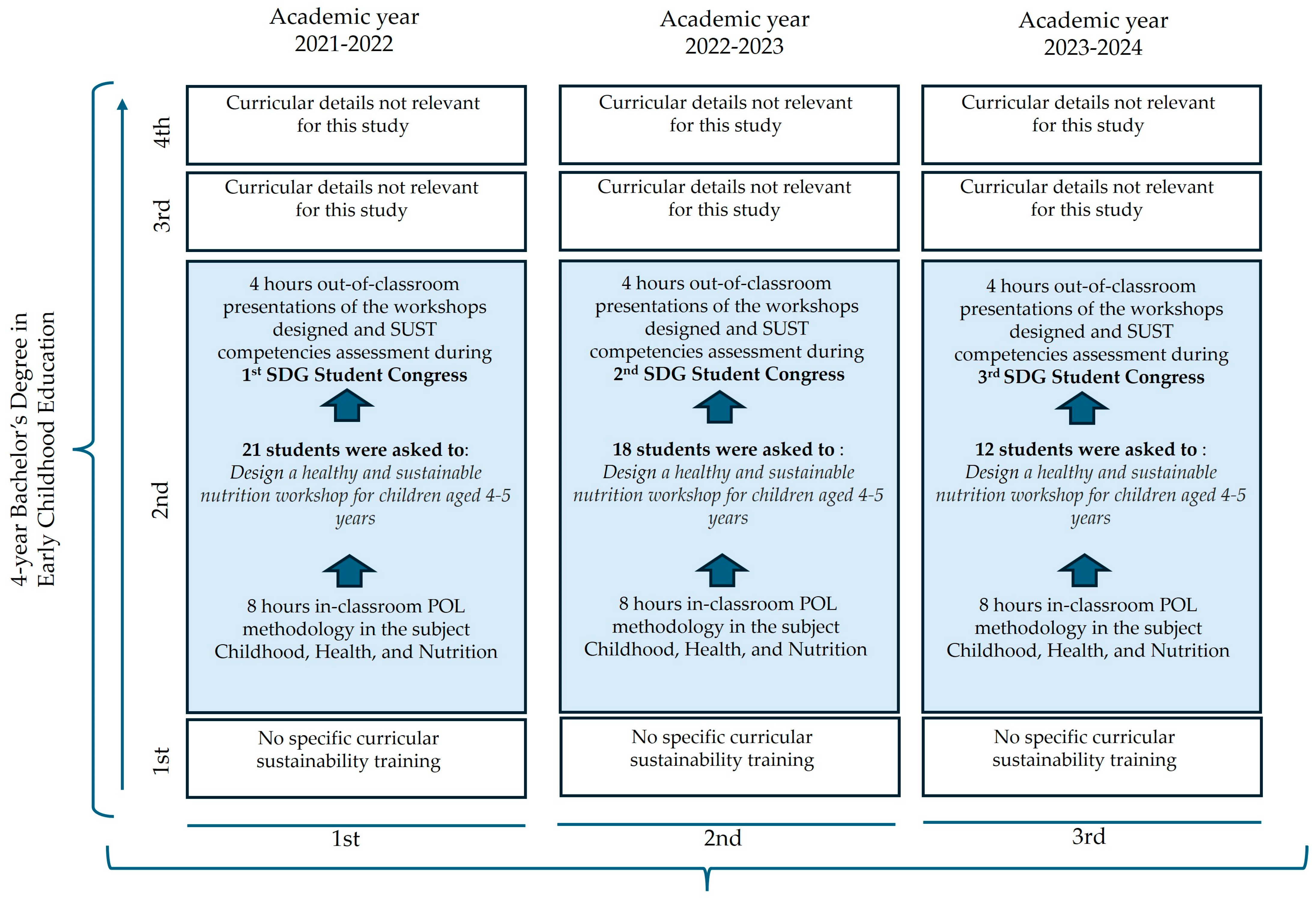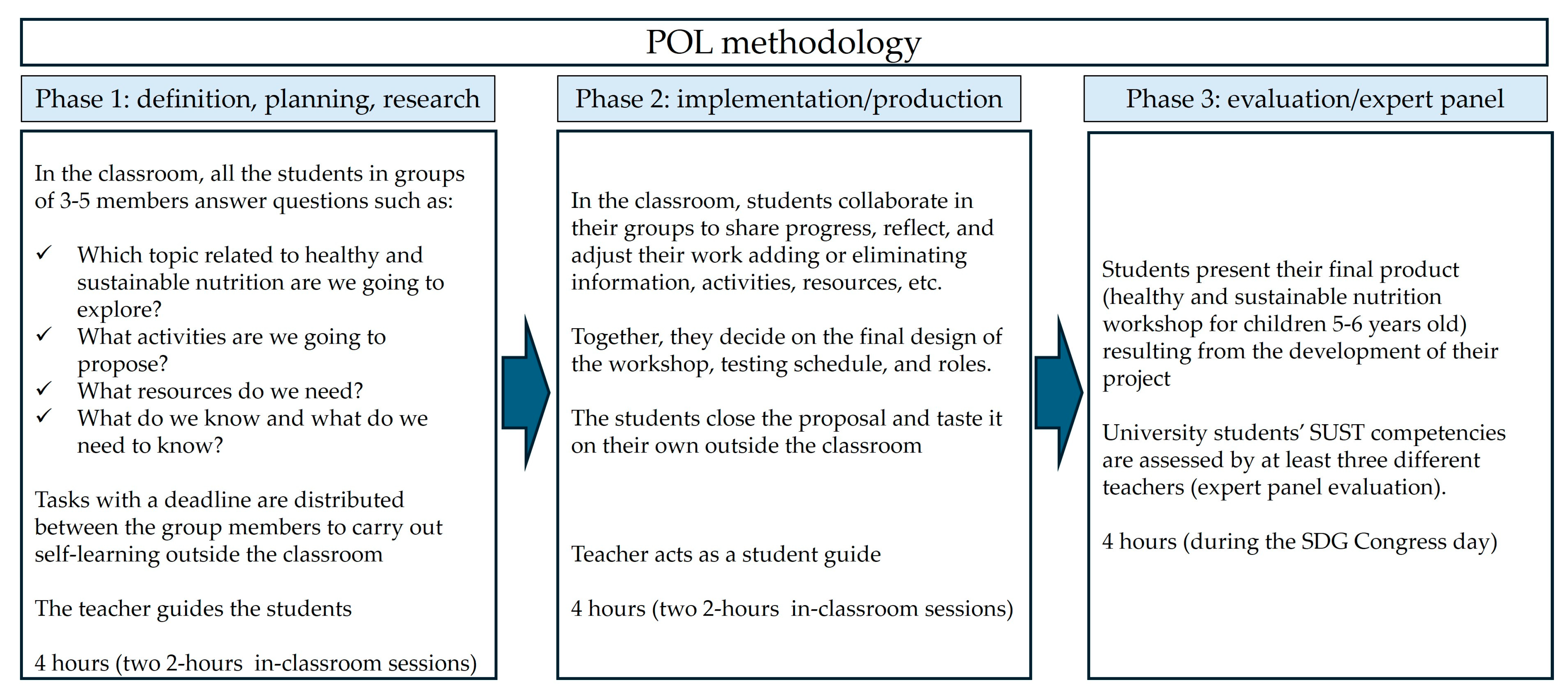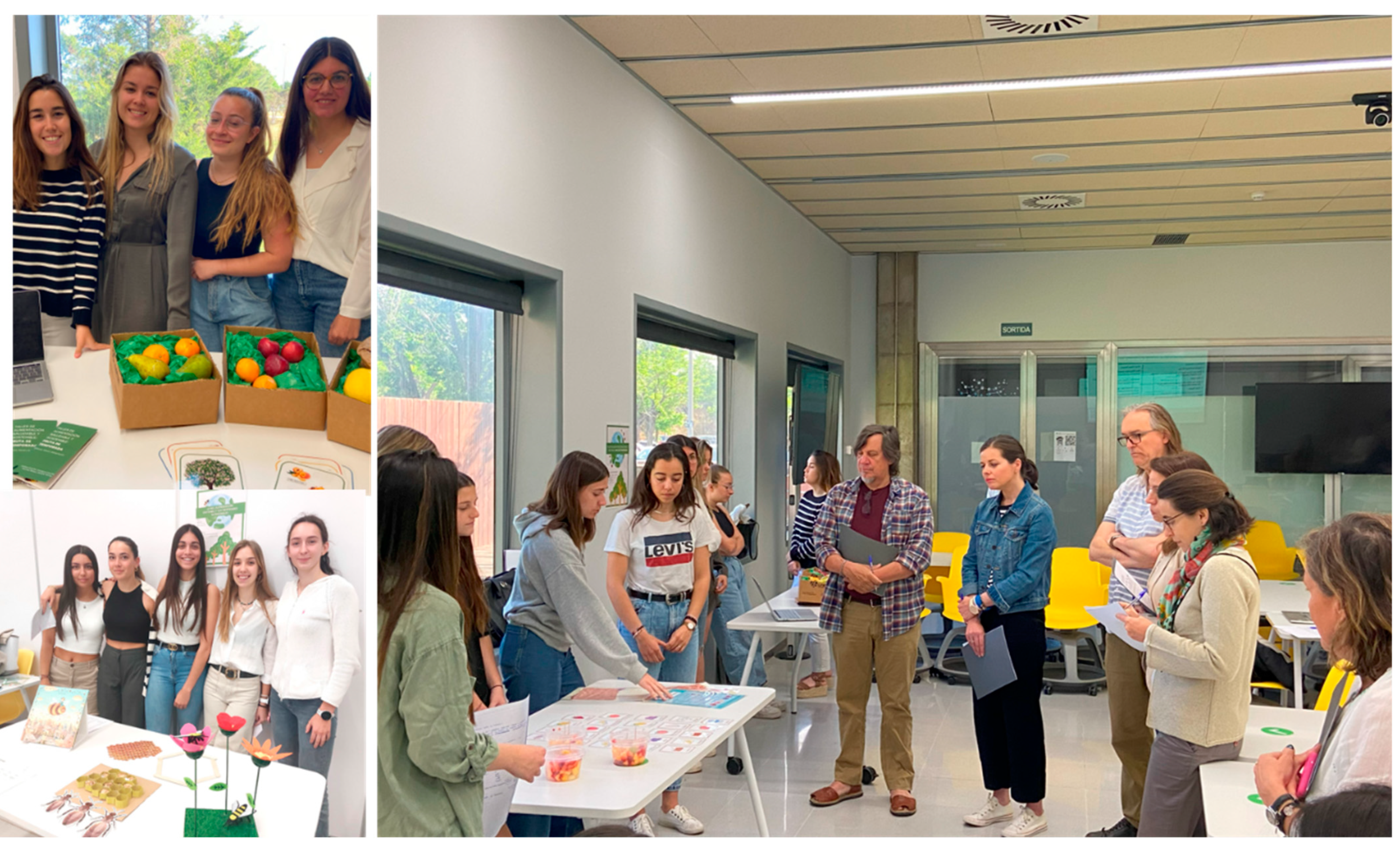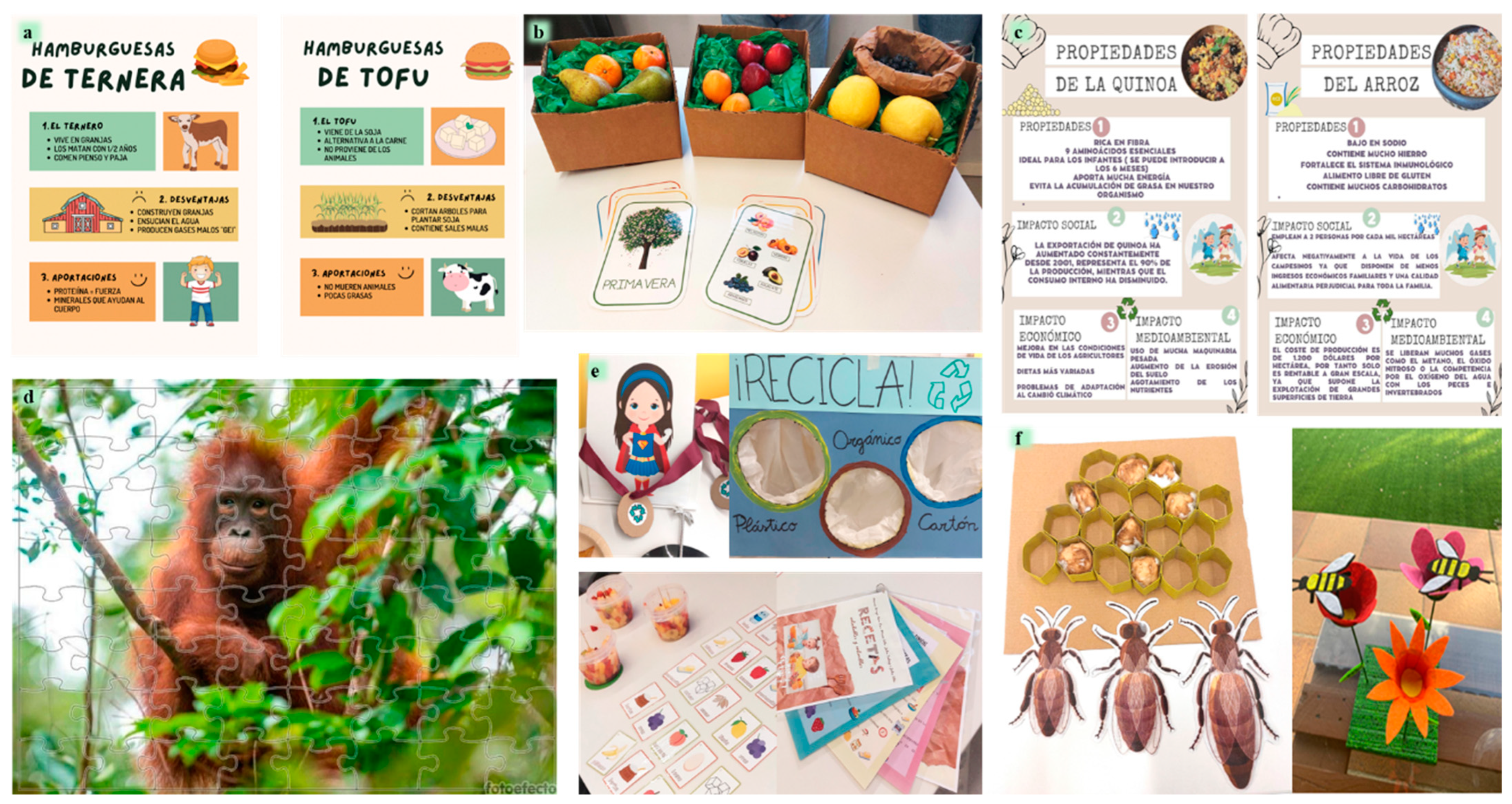Developing Sustainability Competencies Through Healthy and Sustainable Nutrition Workshops in Initial Teacher Training
Abstract
1. Introduction
- To present a curricular proposal to integrate healthy and sustainable nutrition contents into the initial training of early childhood education teachers.
- To analyse university students’ level of cross-curricular sustainability competencies upon completing this proposal.
2. Materials and Methods
2.1. Study Design
2.2. Educational Intervention
2.3. Instrument and Data Analysis
3. Results
3.1. Healthy and Sustainable Nutrition Workshops Designed
3.2. Workshop Presentations and Assessment of Sustainability Competencies
4. Discussion
5. Conclusions
Author Contributions
Funding
Institutional Review Board Statement
Informed Consent Statement
Data Availability Statement
Acknowledgments
Conflicts of Interest
References
- Alam, G. M., Roslan, S., Al-Amin, A. Q., & Leal Filho, W. (2021). Does GATS’ influence on private university sector’s growth ensure ESD or develop city ‘Sustainability Crisis’? Policy framework to respond COP21. Sustainability, 13(8), 4520. [Google Scholar] [CrossRef]
- Albareda-Tiana, S., Fernandez-Borsot, G., Berbegal-Mirabent, J., Regadera-González, E., Mas-Machuca, M., Graell, M., Manresa, A., Fernández-Morilla, M., Fuertes-Camacho, M. T., Gutiérrez-Sierra, A., & Guardiola, J. M. (2024). Enhancing curricular integration of the SDGs: Fostering active methodologies through cross-departmental collaboration in a Spanish university. International Journal of Sustainability in Higher Education, 25(5), 1024–1047. [Google Scholar] [CrossRef]
- Albareda-Tiana, S., Ruíz-Morales, J., Azcárate, P., Valderrama-Hernández, R., & Múñoz, J. M. (2020). The EDINSOST project: Implementing the sustainable development goals at university level. In W. Leal, A. Lange, R. W. Pretorius, L. Londero, E. Manolas, F. Alves, U. Azeiteiro, J. Rogers, C. Shiel, & A. Do Paco (Eds.), Universities as living labs for sustainable development (World Sustainability Series (pp. 179–191). Springer. [Google Scholar] [CrossRef]
- Albareda-Tiana, S., Vidal-Raméntol, S., & Fernández-Morilla, M. (2018a). Implementing the sustainable development goals at university level. International Journal of Sustainability in Higher Education, 19(3), 473–497. [Google Scholar] [CrossRef]
- Albareda-Tiana, S., Vidal-Raméntol, S., Pujol-Valls, M., & Fernández-Morilla, M. (2018b). Holistic approaches to develop sustainability and research competencies in pre-service teacher training. Sustainability, 10(10), 3698. [Google Scholar] [CrossRef]
- Basilotta Gómez-Pablos, V., Torrecilla-Sánchez, E. M., García-Valcárcel Muñoz-Repiso, A., & Hernández-Martín, A. (2020). Project-based learning in the classroom: A case study at high school level. Aula Abierta, 49(4), 429–438. [Google Scholar] [CrossRef]
- Bippert, K., & Espinosa, T. (2019). Project-oriented learning & teaching: Expectations vs. reality. Texas Association of Literacy Education Yearbook, 6, 19–29. [Google Scholar]
- Boo Boo Gaga. (2024, April 12). The recycling song for kids. YouTube Video. Available online: https://www.youtube.com/watch?v=fLZPV3DihAo (accessed on 12 April 2024).
- Browne-Ferrigno, T., & Muth, R. (2012). Use of learner-centered instructional strategies in higher education: Doctoral student assessments. International Journal for the Scholarship of Teaching and Learning, 6(2), 23. [Google Scholar] [CrossRef][Green Version]
- Brundiers, K., Barth, M., Cebrián, G., Cohen, M., Diaz, L., Doucette-Remington, S., Dripps, W., Habron, G., Harré, N., Jarchow, M., Losh, K., Michel, J., Mochizuki, Y., Rieckmann, M., Parnell, R., Walker, P., & Zint, M. (2021). Key competencies in sustainability in higher education—Toward an agreed-upon reference framework. Sustainability Science, 16, 13–29. [Google Scholar] [CrossRef]
- Brundiers, K., & Wiek, A. (2013). Do we teach what we preach? An international comparison of problem-and project-based learning courses in sustainability. Sustainability, 5(4), 1725–1746. [Google Scholar] [CrossRef]
- Cebrián, G., Moraleda, A., Fernández, M., Fuertes, M. T., Segalàs, J., & Gutierrez Blanco, I. (2021). Multiple case-study analysis of service-learning as a means to foster sustainability competencies amongst pre-service educators. Teaching and Teacher Education, 27(6), 488–505. [Google Scholar] [CrossRef]
- Cebrián, G., Segalàs, J., & Hernández, À. (2019). Assessment of sustainability competencies: A literature review and pathways for future research and practice. Central European Review of Economics and Management, 3(3), 19–44. [Google Scholar] [CrossRef]
- Collins, A., Galli, A., Hipwood, T., & Murthy, A. (2020). Living within a one planet reality: The contribution of personal footprint calculators. Environmental Research Letters, 15(2), 025008. [Google Scholar] [CrossRef]
- Diari Oficial de la Generalitat de Catalunya. (2023, February 7). DECRET 21/2023, de 7 de febrer, d’ordenació dels ensenyaments de l’educació infantil. Available online: https://publica.cat/wp-content/uploads/2023/02/DECRET-CURRICULUM-INFANTIL.pdf (accessed on 7 May 2024).
- European Commission. (2025). Key data on early childhood education and care in Europe 2025. Available online: https://op.europa.eu/en/publication-detail/-/publication/bcce2c3d-d93f-11ef-be2a-01aa75ed71a1/language-en#:~:text=This%20third%20edition%20of%20Key%20data%20on%20early,data%20and%20examples%20of%20ECEC%20policies%20across%20Europe (accessed on 20 February 2025).
- Fernandes, S. R. G. (2014). Preparing graduates for professional practice: Findings from a case study of project-based learning (PBL). Procedia—Social and Behavioral Sciences, 139, 219–226. [Google Scholar] [CrossRef]
- Fernández, M., Alférez, A., Vidal, S., Fernández, M. Y., & Albareda, S. (2016). Methodological approaches to change consumption habits of future teachers in Barcelona, Spain: Reducing their personal ecological footprint. Journal of Cleaner Production, 122, 154–163. [Google Scholar] [CrossRef]
- Fernández-Morilla, M., & Fuertes-Camacho, M. T. (2019). Talleres de cocina y educación STEM para niños de 3–6 años. In Estudios sobre innovaciones educativas (pp. 269–280). A. Felipe, B. Peña, & J. Bobkina (Coords.). Editorial Pirámide. [Google Scholar]
- Fináncz, J., Podráczky, J., Deutsch, K., Soós, E., Bánfai-Csonka, H., & Csima, M. (2023). Health education intervention programs in early childhood education: A systematic review. Education Sciences, 13(10), 988. [Google Scholar] [CrossRef]
- Food and Agriculture Organization of the United Nations (FAO). (2011). Global food losses and food waste. Available online: https://openknowledge.fao.org/server/api/core/bitstreams/10388b16-5f1a-45d0-b690-e89bb78d33bb/content (accessed on 13 February 2025).
- Food and Agriculture Organization of the United Nations (FAO) & World Health Organization (WHO). (2019). Sustainable healthy diets: Guiding principles. Available online: https://openknowledge.fao.org/server/api/core/bitstreams/03bf9cde-6189-4d84-8371-eb939311283f/content (accessed on 13 February 2025).
- Generalitat de Catalunya, Departament d’Agricultura, Ramaderia, Pesca i Alimentació. (2025, February 14). Calçot de Valls. Available online: https://agricultura.gencat.cat/ca/ambits/alimentacio/segells-qualitat-diferenciada/distintius-origen/dop-igp/igp/productes-reconeixement-comunitari/calcot-valls (accessed on 2 March 2025).
- Güler Yıldız, T., Öztürk, N., İlhan İyi, T., Aşkar, N., Banko Bal, Ç., & Karabekmez, S. (2021). Education for sustainability in early childhood education: A systematic review. Environmental Education Research, 27(6), 796–820. [Google Scholar] [CrossRef]
- Hadim, H. A., & Esche, S. K. (2002, November 6–9). Enhancing the engineering curriculum through project-based learning. Conference Proceedings of the 32nd Annual Frontiers in Education Conference, Boston, MA, USA. Available online: https://ieeexplore.ieee.org/document/1158200 (accessed on 2 March 2025).
- Hansen, T., & Thomsen, T. U. (2018). The influence of consumers’ interest in healthy eating, definitions of healthy eating, and personal values on perceived dietary quality. Food Policy, 80, 55–67. [Google Scholar] [CrossRef]
- Happy Learning. (2024, April 20). The three Rs. YouTube Video. Available online: https://www.youtube.com/watch?v=OasbYWF4_S8 (accessed on 20 April 2024).
- Hazley, D., & Kearney, J. M. (2023). Consumer perceptions of healthy and sustainable eating. Proceedings of the Nutrition Society, 83, 254–262. [Google Scholar] [CrossRef]
- Horn, A., Visser, M. W., Pittens, C. A. C. M., Urias, E., Zweekhorst, M. B. M., & van Dijk, G. M. (2024). Transdisciplinary learning trajectories: Developing action and attitude in interplay. Humanities and Social Sciences Communications, 11, 149. [Google Scholar] [CrossRef]
- Hort urbà al balcó. (2024, April 20). Plantem calçots. YouTube Video. Available online: https://www.youtube.com/watch?v=A2ty8tnL-FI (accessed on 20 April 2024).
- Hu, F. B., Otis, B. O., & McCarthy, G. (2019). Can plant-based meat alternatives be part of a healthy and sustainable diet? JAMA, 322(16), 1547–1548. [Google Scholar] [CrossRef]
- Jay, A. (2017). L’abella i jo [The bee and I]. Editorial Juventud. [Google Scholar]
- Joshi, V. K., & Kumar, S. (2015). Meat analogues: Plant-based alternatives to meat products—A review. International Journal of Food Fermentation Technology, 5(2), 107–119. [Google Scholar] [CrossRef]
- Junyent, M., & de Ciurana, A. M. G. (2008). Education for sustainability in university studies: A model for reorienting the curriculum. British Educational Research Journal, 34(6), 763–782. [Google Scholar] [CrossRef]
- Kerlinger, F., & Lee, H. (1999). Foundations of behavioral research (4th ed.). Wadsworth Publishing. [Google Scholar]
- Korniaki, E. N., Skouteris, H., & Morris, H. (2021). Developing connections between healthy living and environmental sustainability concepts in Cretan preschool children: A randomized trial. Early Child Development and Care, 192(12), 1685–1698. [Google Scholar] [CrossRef]
- Lee, R. E., Szeszulski, J., Lorenzo, E., Arriola, A., Bruening, M., Estabrooks, P. A., Hill, J. L., O’Connor, T. M., Shaibi, G. Q., & Soltero, E. G. (2022). Sustainability via active garden education: The sustainability action plan model and process. International Journal of Environmental Research and Public Health, 19(1), 5511. [Google Scholar] [CrossRef]
- Lozano, R. (2006). A tool for a graphical assessment of sustainability in universities (GASU). Journal of Cleaner Production, 14(9–11), 963–972. [Google Scholar] [CrossRef]
- Lozano, R. (2008). Envisioning sustainability three-dimensionally. Journal of Cleaner Production, 16(17), 1838–1846. [Google Scholar] [CrossRef]
- López-Banet, L., Miguélez Rosique, J. A., Martínez-Carmona, M., & Ayuso Fernández, G. E. (2022). Development of food competence in early childhood education. Education Sciences, 12(2), 64. [Google Scholar] [CrossRef]
- Martinez-Gonzalez, M. A., Holgado, B., Gibney, M., Kearney, J., & Martinez, J. A. (2000). Definitions of healthy eating in Spain as compared to other European member states. European Journal of Epidemiology, 16, 557–564. [Google Scholar] [CrossRef]
- Mcdonald, S., Oates, C. J., Alevizou, P. J., Young, C. W., & Hwang, K. (2012). Individual strategies for sustainable consumption. Journal of Marketing Management, 28(3–4), 445–468. [Google Scholar] [CrossRef]
- Miller, G. E. (1990). The assessment of clinical skills/competence/performance. Academic Medicine, 65(9), S63–S67. [Google Scholar] [CrossRef]
- Mosier, G., Levine, J., & Perkins, T. (2016). Students’ perceptions of project-based learning within the new tech school model. International Journal of Educational Reform, 25(1), 2–15. [Google Scholar] [CrossRef]
- Nestlé Global. (2024). Plant-based portfolio. Available online: https://www.nestle.com/brands/plant-based-portfolio (accessed on 2 March 2025).
- Organisation for Economic Co-operation and Development. (2024). TALIS 2013 results: An international perspective on teaching and learning. Available online: https://www.oecd-ilibrary.org/docserver/9789264196261-en.pdf (accessed on 5 June 2024).
- Pritchard, D. J., Ashley, T., Connolly, H., & Worsfold, N. (2018). Transforming collaborative practices for curriculum and teaching innovations with the sustainability forum (University of Bedfordshire). In W. Leal Filho (Ed.), Implementing sustainability in the curriculum of universities (World Sustainability Series). Springer. [Google Scholar] [CrossRef]
- Rieckmann, M. (2018). Learning to transform the world: Key competencies in education for sustainable development. Issues and Trends in Education for Sustainable Development, 39(1), 39–59. [Google Scholar]
- Rodríguez, J., Laverón-Simavilla, A., del Cura, J. M., Ezquerro, J. M., Lapuerta, V., & Cordero-Gracia, M. (2015). Project-based learning experiences in the space engineering education at Technical University of Madrid. Advances in Space Research, 56(7), 1319–1330. [Google Scholar] [CrossRef]
- Salas Blas, E. (2013). Pre-experimental designs in psychology and education: A conceptual review. Liberabit, 19, 133–141. [Google Scholar]
- Simó Cruanyes, J. (2013). Millora genètica del calçot (Allium cepa L.): Desenvolupament d’eines de selecció i aplicació a l’obtenció de nous cultivars [Doctoral dissertation, Universitat Politècnica de Catalunya]. Universitat Politècnica de Catalunya Repository. [Google Scholar]
- Spanish Society of Nutrition. (2018, June 27). Alimentación 5S. XVII Congress of the Spanish Society of Nutrition, Barcelona, Spain. Available online: http://www.sennutricion.org/es/2018/06/27/xvii-congreso-de-la-sociedad-espaola-de-nutricin-sen (accessed on 16 May 2024).
- Sustainable Development Solutions Network. (2017). Getting started with the SDGs in universities. Available online: https://ap-unsdsn.org/wp-content/uploads/University-SDG-Guide_web.pdf (accessed on 22 May 2024).
- Sustainable Development Solutions Network. (2020). Sustainable development report. Available online: https://files.unsdsn.org/University-SDG-Guide_web.pdf (accessed on 22 May 2024).
- Tamim, S. R., & Grant, M. M. (2013). Definitions and uses: Case study of teachers implementing project-based learning. Interdisciplinary Journal of Problem-Based Learning, 7(2), 72–101. [Google Scholar] [CrossRef]
- Tejedor, G., Segalàs, J., Barrón, Á., Fernández-Morilla, M., Fuertes, M. T., Ruiz-Morales, J., & Hernández, À. (2019). Didactic strategies to promote competencies in sustainability. Sustainability, 11(7), 2086. [Google Scholar] [CrossRef]
- Tilbury, D. (2011). Higher education for sustainability: A global overview of commitment and progress. Higher Education in the World, 4(1), 18–28. [Google Scholar]
- United Nations. (2015). Transforming our world: The 2030 agenda for sustainable development. Available online: https://sdgs.un.org/sites/default/files/publications/21252030%20Agenda%20for%20Sustainable%20Development%20web.pdf (accessed on 14 May 2024).
- United Nations Development Programme. (2015). The millennium development goals report. Available online: https://www.undp.org/sites/g/files/zskgke326/files/publications/es/UNDP_MDG_Report_2015.pdf (accessed on 14 May 2024).
- United Nations Development Programme. (2024). UNDP trends report. Available online: https://www.undp.org/sites/g/files/zskgke326/files/2024-02/undp_trends_report_2024_0.pdf#:~:text=This%20report%20aims%20to%20help%20UNDP%20colleagues%20orient,out%20there%2C%20this%20one%20is%20written%20for%20UNDP (accessed on 16 May 2024).
- United Nations Environment Programme. (2024). Food waste index report. Available online: https://wedocs.unep.org/handle/20.500.11822/45230 (accessed on 14 May 2024).
- United Nations Framework Convention on Climate Change. (2024, September 30). Food loss and waste account for 8–10% of annual global greenhouse gas emissions; Cost USD 1 trillion annually. Available online: https://unfccc.int/news/food-loss-and-waste-account-for-8-10-of-annual-global-greenhouse-gas-emissions-cost-usd-1-trillion (accessed on 10 February 2025).
- Vilaplana, R., Hyder, A., & Gomis, O. (2010). Working in terms of competences: Activities designed using active methodologies. In S. Soomro (Ed.), New achievements in technology education and development (pp. 357–373). INTECH Open Access Publisher. [Google Scholar]
- Wiek, A., Withycombe, L., Redman, C., & Mills, S. B. (2011). Moving forward on competence in sustainability research and problem solving. Environment, 53(2), 3–13. [Google Scholar] [CrossRef]





| Sustainability Competency | Level 1. Knows (0.5–1) | Level 2. Knows How (1–1.5) | Level 3. Shows How and Does (1.5–2) |
|---|---|---|---|
| SUST 1. Competency in the critical contextualisation of knowledge, establishing inter-relationships between local and/or global social, economic, and environmental issues | Knows the functioning of natural, social, and economic systems and the mutual relationships between them | Analyses and understands the relationship between natural systems and social and economic systems | Can imagine and predict the impacts that the changes produced in natural systems may cause in social and economic systems and between each other |
| SUST 2. Competency in the sustainable use of resources and in the prevention of negative impacts on natural and social environments | Has basic knowledge of identifying possible socio-environmental impacts derived from educational actions | Knows how to develop educational actions that mitigate negative socio-environmental impacts | Designs and develops educational activities in which negative socio-environmental impacts are considered and incorporates mitigating measures |
| Academic Year 2021–2022 | |
|---|---|
| Summary of Activities * | Learning Objectives |
| Healthy and sustainable recipes | |
|
|
| Honey: its sustainable production and nutritional properties | |
|
|
| The three “R’s”: reduce, reuse, and recycle | |
|
|
| Seasonal fruit: healthy and sustainable | |
|
|
| Academic Year 2022–2023 | |
|---|---|
| Summary of Activities * | Learning Objectives |
| Quinoa or rice? | |
|
|
| Healthy and sustainable: cocoa! | |
|
|
| The impact of palm oil | |
|
|
| Test your taste buds! beef burger vs. tofu burger | |
|
|
| Academic Year 2023–2024 | |
|---|---|
| Summary of Activities * | Learning Objectives |
| Beyond meat | |
|
|
| Growing calçots 1 | |
|
|
| Academic Year | SUST 1 (Over 10) | SUST 2 (Over 10) | ||
|---|---|---|---|---|
| 2021–2022 | 1 | Healthy and sustainable recipe book | 6.5 | 8.95 |
| 2 | Honey: its sustainable production and nutritional properties | 8.15 | 8.15 | |
| 3 | The three “R’s”: reduce, reuse, and recycle | 8 | 7.9 | |
| 4 | Seasonal fruit: healthy and sustainable | 7.1 | 7.9 | |
| Average | 7.43 | 8.22 | ||
| SD | 0.77 | 0.49 | ||
| 2022–2023 | 5 | Quinoa or rice? | 6.5 | 9.5 |
| 6 | Healthy and sustainable: cocoa! | 7.1 | 6.25 | |
| 7 | The impact of palm oil | 6.65 | 8.35 | |
| 8 | Test your taste buds! beef burger vs. tofu burger | 6.9 | 7.1 | |
| Average | 6.78 | 7.80 | ||
| SD | 0.26 | 1.42 | ||
| 2023–2024 | 9 | Beyond meat | 10 | 7.5 |
| 10 | Growing calçots | 5.5 | 6.5 | |
| Average | 7.75 | 7.00 | ||
| SD | 3.18 | 0.70 |
Disclaimer/Publisher’s Note: The statements, opinions and data contained in all publications are solely those of the individual author(s) and contributor(s) and not of MDPI and/or the editor(s). MDPI and/or the editor(s) disclaim responsibility for any injury to people or property resulting from any ideas, methods, instructions or products referred to in the content. |
© 2025 by the authors. Licensee MDPI, Basel, Switzerland. This article is an open access article distributed under the terms and conditions of the Creative Commons Attribution (CC BY) license (https://creativecommons.org/licenses/by/4.0/).
Share and Cite
Fernández-Morilla, M.; Albareda-Tiana, S. Developing Sustainability Competencies Through Healthy and Sustainable Nutrition Workshops in Initial Teacher Training. Educ. Sci. 2025, 15, 321. https://doi.org/10.3390/educsci15030321
Fernández-Morilla M, Albareda-Tiana S. Developing Sustainability Competencies Through Healthy and Sustainable Nutrition Workshops in Initial Teacher Training. Education Sciences. 2025; 15(3):321. https://doi.org/10.3390/educsci15030321
Chicago/Turabian StyleFernández-Morilla, Mónica, and Silvia Albareda-Tiana. 2025. "Developing Sustainability Competencies Through Healthy and Sustainable Nutrition Workshops in Initial Teacher Training" Education Sciences 15, no. 3: 321. https://doi.org/10.3390/educsci15030321
APA StyleFernández-Morilla, M., & Albareda-Tiana, S. (2025). Developing Sustainability Competencies Through Healthy and Sustainable Nutrition Workshops in Initial Teacher Training. Education Sciences, 15(3), 321. https://doi.org/10.3390/educsci15030321







